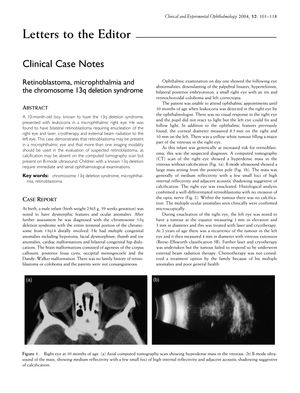Clinical Case Notes: Castleman's Disease of the Lacrimal Gland
February 2004
in “
Clinical and Experimental Ophthalmology
”

TLDR The document discusses various eye conditions and their treatments, including a rare eye cancer in a baby, vision loss from a cancer drug, cataracts from a baldness treatment, a rare skin disorder, and a specific type of eye disease diagnosed with a special imaging technique.
In 2004, several case studies were reported. One involved a 10-month-old boy with 13q deletion syndrome who was diagnosed with bilateral retinoblastoma, a rare form of eye cancer. The case highlighted the importance of using multiple imaging modalities for evaluation. Another case involved a 68-year-old woman with metastatic breast cancer who experienced progressive visual loss due to tamoxifen, a chemotherapeutic agent. Her vision improved dramatically upon cessation of the drug. A 43-year-old man developed bilateral cataracts after using Propecia (finasteride) for 3 years to treat male pattern baldness. His visual acuity improved after discontinuing the medication and undergoing cataract extraction. This was the first reported case of Propecia-associated cataract. The document also discussed Lipoid Proteinosis, a rare, recessively inherited disorder characterized by non-inflammatory, persistent papules on the skin and mucous membranes. Lastly, the document presented two clinical cases of Adult-onset Foveomacular Vitelliform Dystrophy (AOFVD), a disease characterized by a focal, round or oval shaped, subretinal foveal yellow lesion. The use of Optical Coherence Tomography (OCT) was discussed in diagnosing and studying the disease.
